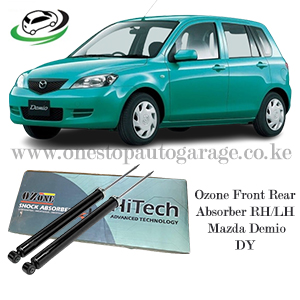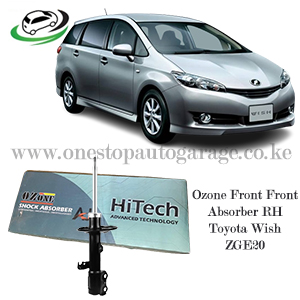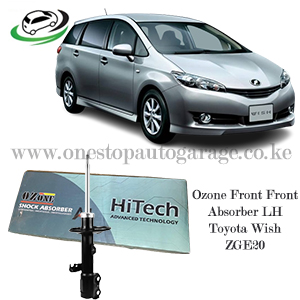-14%
Get Ozone Front Shock Absorber Assy LH Toyota Wish ZGE20 3340065
Shock absorbers, also known as dampers, are crucial components in a vehicle’s suspension system. They play a vital role in controlling the impact and rebound movement of a vehicle’s springs and suspension. By doing so, they enhance ride quality and vehicle handling, ensuring safety and comfort for passengers.
Function and Importance
The primary function of shock absorbers is to absorb and dissipate kinetic energy. When a vehicle travels over uneven terrain, the springs compress and expand to absorb the bumps. Without shock absorbers, the vehicle would continue to bounce, making it difficult to control. Shock absorbers dampen these oscillations by converting the kinetic energy into heat, which is then dissipated into the atmosphere.
Key benefits of shock absorbers include:
1. Improved Comfort
Shock absorbers play a crucial role in enhancing the comfort of a vehicle by smoothing out the ride. Here’s how:
- Damping Road Impacts: When a vehicle travels over rough terrain, bumps, or potholes, the suspension system absorbs the initial shock. Shock absorbers then dampen the oscillations of the springs, preventing the vehicle from bouncing excessively. This damping effect ensures that passengers experience fewer jolts and vibrations, resulting in a smoother and more comfortable ride.
- Reduced Vibrations: Shock absorbers also minimize the vibrations transmitted through the vehicle’s chassis. This is particularly important on long journeys or uneven roads, where constant vibrations can lead to discomfort and fatigue for passengers.
2. Enhanced Safety
Safety is a paramount concern in automotive design, and shock absorbers contribute significantly to this aspect:
- Maintaining Tire Contact: One of the primary safety functions of shock absorbers is to keep the tires in contact with the road surface. By controlling the movement of the suspension, they ensure that the tires do not lose contact, especially during high-speed driving or on rough surfaces. Consistent tire contact is essential for effective braking, steering, and overall vehicle control.
- Stability During Maneuvers: Shock absorbers improve the stability of a vehicle during sharp turns, sudden stops, or evasive maneuvers. By dampening the body roll and pitch, they help maintain the vehicle’s balance and reduce the risk of skidding or rollover.
3. Prolonged Tire Life
Properly functioning shock absorbers can significantly extend the life of a vehicle’s tires:
- Even Tire Wear: Shock absorbers help distribute the vehicle’s weight evenly across all four tires, preventing uneven wear. Without effective damping, the tires would experience excessive bouncing and oscillations, leading to irregular tire wear patterns and reducing their lifespan.
- Reduced Stress on Tires: By absorbing and dissipating the energy from road impacts, shock absorbers reduce the stress and strain on the tires. This helps in preventing premature tire failure and ensures that the tires maintain their performance characteristics for a longer period.
4. Better Handling and Control
Shock absorbers are critical for maintaining the handling characteristics of a vehicle:
- Precise Steering Response: Good shock absorbers enhance the vehicle’s steering response by controlling the suspension movement. This ensures that the driver has a more precise and predictable control over the vehicle, particularly during cornering or rapid lane changes.
- Reduced Body Roll: During turns and cornering, shock absorbers reduce the amount of body roll. This not only improves the vehicle’s stability but also enhances the driver’s confidence in the vehicle’s handling capabilities.
- Minimized Brake Dive and Acceleration Squat: Shock absorbers help control the dive that occurs during hard braking and the squat that happens during rapid acceleration. This control improves the overall balance of the vehicle and ensures that the weight distribution remains optimal for handling and safety.
5. Protection of Other Vehicle Components
Shock absorbers play a protective role for other components of the vehicle’s suspension system:
- Preventing Suspension Damage: By controlling the movement of the suspension, shock absorbers reduce the stress on other components such as springs, control arms, and bushings. This helps in preventing premature wear and damage to these parts.
- Reducing Chassis Stress: The damping action of shock absorbers minimizes the transfer of road shocks and vibrations to the vehicle’s chassis. This reduces the risk of cracks, fatigue, and other forms of structural damage to the vehicle’s frame and body.
6. Enhanced Performance in Varied Conditions
Modern shock absorbers are designed to perform optimally across a wide range of driving conditions:
- Adaptability to Road Conditions: Advanced shock absorbers, such as electronically controlled or magnetorheological dampers, can adjust their damping characteristics in real-time. This adaptability ensures optimal performance whether driving on smooth highways, rough off-road trails, or any surface in between.
- Consistency Across Temperatures: High-quality shock absorbers are built to perform consistently across different temperature ranges. This ensures that the damping performance does not degrade in extreme hot or cold conditions, maintaining comfort and control year-round.
Types of Shock Absorbers
Shock absorbers come in various designs, each with its unique features and applications. The most common types include:
- Twin-Tube Shock Absorbers:
- Basic Twin-Tube: Comprises two nested tubes—the inner tube (working tube) and the outer tube (reservoir tube). The working tube houses the piston, while the reservoir tube stores excess hydraulic fluid.
- Gas-Charged Twin-Tube: Similar to the basic design but includes a low-pressure nitrogen gas charge to reduce fluid aeration, improving performance and reducing fade.
- Mono-Tube Shock Absorbers:
- Consist of a single tube housing the piston and hydraulic fluid. They feature a separate chamber for the gas charge, usually high-pressure nitrogen. This design offers better cooling and consistent performance, making it ideal for high-performance and off-road applications.
- Coilover Shock Absorbers:
- Combine a shock absorber and a coil spring into a single unit. They allow for ride height and damping adjustments, commonly used in performance and racing vehicles.
- Electronic Shock Absorbers:
- Feature electronically controlled valves to adjust the damping force in real-time. These systems can adapt to changing road conditions and driving styles, offering a balance between comfort and performance.
Signs a Shock Absorber is worn Out;
1. Excessive Bouncing and Swaying
- Bounce Test: One of the simplest tests to check for worn shock absorbers is the bounce test. Push down hard on the corner of the vehicle and release it. If the vehicle bounces more than 2-3 times before settling, the shock absorbers may be worn out.
- Swaying During Turns: If the vehicle sways excessively or feels unstable during turns, it could indicate that the shock absorbers are no longer effectively controlling the suspension movement.
2. Longer Braking Distances
- Increased Stopping Distance: Worn shock absorbers can significantly affect the braking performance of a vehicle. They can cause the wheels to lose contact with the road surface during braking, leading to increased stopping distances.
- Nosedive While Braking: If the front of the vehicle dips excessively during braking, it’s a sign that the front shock absorbers are not effectively damping the suspension movement.
3. Uneven Tire Wear
- Cupping or Scalloping: Worn shock absorbers can cause the tires to bounce excessively, leading to uneven tire wear patterns such as cupping or scalloping. This irregular wear can reduce tire life and affect the vehicle’s handling and safety.
- Feathering: Another pattern of uneven tire wear caused by worn shock absorbers is feathering, where the tread ribs develop a sawtooth-like pattern.
4. Leaking Fluid
- Hydraulic Fluid Leaks: Shock absorbers contain hydraulic fluid that can leak out if the seals are damaged or the shock absorber is worn. Visible fluid leaks on the shock absorber body or on the ground underneath the vehicle are clear signs of wear.
- Dampness Around the Shock Area: Even if there’s no noticeable puddle, dampness or oily residue around the shock absorber indicates a possible leak.
5. Unusual Noises
- Clunking or Knocking Sounds: Worn shock absorbers can produce clunking or knocking sounds when driving over bumps or rough roads. This noise occurs because the internal components of the shock absorber may be damaged or loose.
- Squeaking or Groaning: A squeaking or groaning sound when the vehicle’s suspension moves can also indicate worn shock absorbers, particularly if the noise is persistent and occurs under normal driving conditions.
6. Poor Ride Quality
- Rough Ride: One of the most noticeable signs of worn shock absorbers is a decrease in ride quality. The vehicle may feel rough or harsh over bumps and uneven road surfaces because the shock absorbers are no longer effectively dampening the suspension movements.
- Increased Vibration: Excessive vibrations felt through the steering wheel or the vehicle’s body can indicate that the shock absorbers are not performing adequately.
7. Vehicle Instability
- Lack of Control: A vehicle with worn shock absorbers may feel unstable, especially at higher speeds or during sudden maneuvers. The driver may have difficulty maintaining control, particularly on winding roads or during emergency swerves.
- Floating Sensation: A floating or drifting sensation when driving on smooth roads is another sign that the shock absorbers are worn. This occurs because the shocks are not keeping the tires firmly planted on the road.
8. Uneven or Rapid Suspension Movement
- Oscillation: If the vehicle’s suspension continues to oscillate excessively after encountering a bump, it indicates that the shock absorbers are no longer damping the suspension movement effectively.
- Rear Squat: When accelerating, a vehicle with worn rear shock absorbers may experience excessive squat, where the rear end dips significantly. This affects traction and handling.
9. Visual Inspection
- Physical Damage: Inspecting the shock absorbers for physical damage, such as dents, cracks, or bends, can help identify worn or damaged components.
- Sagging: A vehicle that sags more on one side could indicate a problem with the shock absorbers on that side.
10. Decreased Performance in Various Driving Conditions
- Poor Handling on Rough Roads: Worn shock absorbers may struggle to maintain performance on rough or uneven roads, leading to a decrease in handling and comfort.
- Reduced Effectiveness in Extreme Temperatures: Shock absorbers that have been compromised may not perform well in extreme hot or cold conditions, leading to inconsistent damping and vehicle control.
Follow us on Facebook for more parts.



